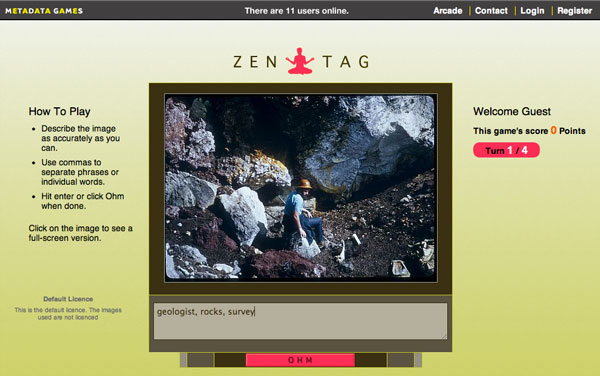The challenge: You have two minutes to educate a Stupid Robot by describing the picture below as precisely as possible. The catch: you can only list one word of any given length from 4-10 letters, and the robot will reject words it already knows. Therefore, you must be accurate, creative, and specific all at once.
If, like me, you found this challenge oddly entertaining, you might enjoy Metadata Games, a set of interactive tagging games designed to help libraries and museums crowdsource useful metadata for their collections.
Metadata Games was developed by Tiltfactor, a research laboratory at Dartmouth College that focuses on designing socially conscious games, and is supported by funding from the National Endowment for the Humanities and the American Council of Learned Societies. These games could help libraries and museums address a major current challenge–digitally preserving image, audio, and video collections by making them searchable online.
Why Collect Metadata?

What’s a cupcake without the rich creamy center? Image via flarnie.com.
Metadata, in this context, is basically everything we might want to know about a digital text, image, or clip in order to find it, from content, to form, to context. It is collected through descriptive words called tags. Libraries and museums need to create accurate, specific, and varied tags to categorize material and make it searchable online.
Mary Flanagan, founding director of Tiltfactor, points out that although Google is working on digitizing and creating metadata for books through the Google Books Library Project, this project is time consuming and limited because it doesn’t extend to creating metadata for image, video, and audio archives.
Creating descriptive tags for an image or clip might seem simple, but a few keywords are not enough. For instance, “ship” might be an obvious tag for the image above, but if I am searching for “ocean”, “naval”, “art”, “French”, or “flag”, this image might also be useful and I should be able to find it in my search. Context also affects how we search–an art historian searching for a specific watercolor may need the same image as a child trying to find an interesting painting she vaguely remembers seeing in a museum, but they probably will not use the same words to look for it.
Since a computer can’t interpret visual and audio materials the way a human can, generating multitudes of words at different levels of specificity on different aspects of each image or clip put online is a monumental task.
Help Via Crowdsourcing?
In essence, Metadata Games provides miniature volunteer opportunities for community members to use their particular perspectives, interests, and expertise to help libraries and museums accomplish this monumental task. They do that in an entertaining and educational way that also exposes these members to collections they

A screenshot from Metadatagames.org.
might not otherwise know about. The Metadata Games FAQ suggests that institutions add these tags, which may include “everything from colloquial folksonomies to formal, specialized terms” to their search engines to enhance search functionality. The website itself also includes a database of all tagged images for people to explore. The software is open source and free, so institutions can customize the games to fit their particular needs.
Various institutions are using Metadata Games to publicize their digitized collections and gather metadata. The British Library is using the games to add tags to naval images, 16th-18th century portraits, and old book covers and title pages. The University of California, Irvine Library is doing a project called Anteater Tag (named after UCI’s mascot), using Metadata Games to crowdsource information about photographs of UCI from 1963-1982. Other partners include the American Antiquarian Society, the Boston Public Library, the UCLA Chicano Studies Research Center, the Yale University Library, and more.
What Are The Games Like?
Metadata Games are available online or as Apple and Android apps. There are timed and untimed individual games as well as two-player games, such as Guess What!, in which a player gives descriptions to help a partner guess an image.
I played several different games and particularly enjoyed Stupid Robot for its time challenge, cheery music, and robot graphic.

An online game of metadata tag, on Zen Tag. Image via tiltfactor.org.
The image from the British Library’s collections at the top of this post came from a game of Zen Tag, an untimed game that allows players to use any words they like and awards points for novel tags. I liked that Zen tag presented four images in each game, intriguing, but not overwhelming me. The short clips in NexTag, Zen Tag for audio and video clips, were fascinating.
Overall, I found the games interesting and educational. They definitely provide an exciting opportunity for libraries and museums to engage people in exploring new collections.
Want to Learn More?
Play some Metadata Games or check out this paper by the developers on using game design to address issues related to motivation and quality control in crowdsourced tagging.
What are your thoughts on crowdsourcing metadata? Have you played any Metadata Games and what did you think of them? How else might we use games to raise awareness of libraries and museums and their collections?

